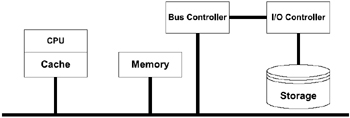2.2 Uniprocessor model
|
| < Day Day Up > |
|
The uniprocessor model has the simplest architecture, including a single processor (that interprets and executes computer instructions) and cache connected to the memory and I/O controllers through a shared bus. Devices on this bus communicate with the CPU and memory bus by a bridge between the two buses. A common example of this type of architecture is the antiquated personal computers (PCs) such as the 486 and 586.
Due to the nature of this architecture, applications, or servers, may not be suitable for this structure. Most application and database engines today have many processes and a single processor environment would be inefficient. This is specifically true in the case of Oracle. Oracle has a multiprocess architecture; its background processes DBWR, LGWR, PMON, SMON, etc., contend for CPU resources, and serious performance concerns arise when they are run in a uniprocessor environment. Consequently, this implies that, at any time, only one person can execute an SQL statement or a PL/SQL package or make an OCI request to the database.
The architecture in Figure 2.1 has only one processing engine in the system. For implementations of Oracle multiprocess architecture, the uniprocessor architecture with just one processor brought about significant restrictions. Uniprocessors are more suited for home computing and simple stand-alone applications that do not require a database environment.

Figure 2.1: Single processor (uniprocessor) architecture.
The alternative system to the uniprocessor model is the multiprocessor model. As the name indicates, multiprocessor models have two or more CPUs or processors.
|
| < Day Day Up > |
|
EAN: 2147483647
Pages: 174